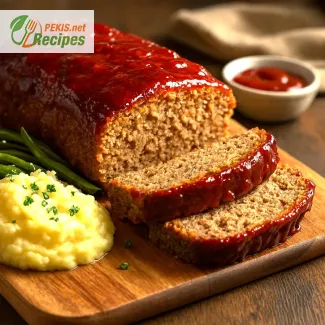
The Ultimate Comfort Food: A Juicy Meatloaf Worth Every Bite
Discover why this beloved meatloaf recipe has stood the test of time
Few dishes evoke a sense of warmth and nostalgia like a perfectly baked meatloaf. Rooted deeply in American culinary tradition, this dish has been a weeknight staple in countless households for generations. Whether served with buttery mashed potatoes, crisp green beans, or a rich brown gravy, meatloaf delivers both comfort and satisfaction in every slice. What makes this recipe truly special is its tender texture, rich umami flavor, and the subtle blend of spices that make it feel like a hug on a plate.
Unlike other complicated mains that demand hours of prep, meatloaf is straightforward yet deeply flavorful, making it ideal for busy families and casual gatherings alike. This version, in particular, is carefully crafted to be juicy on the inside with a lightly caramelized crust, offering the kind of balance that elevates it from ordinary to unforgettable.
The secret to a standout meatloaf lies in a few key choices: high-quality ground beef, the right ratio of breadcrumbs to milk for moisture, and a mix of aromatics like sautéed onions and garlic. But what truly sets this recipe apart is its signature glaze—a glossy topping made from ketchup, brown sugar, and a hint of mustard—that adds a sweet and tangy finish that complements the savory meat beautifully.
For many, meatloaf is more than just a meal—it’s a tradition. Passed down from one generation to the next, it reflects the ingenuity of home cooks who found ways to make economical ingredients shine. Today, the humble meatloaf has taken on new life in modern kitchens, where chefs and home cooks alike experiment with different seasonings, add-ins like cheese or herbs, and even stuffing it with surprise elements like boiled eggs or sautéed mushrooms.
This version sticks to the classic approach, honoring its roots while ensuring a moist, flavorful result every time. Whether you’re a lifelong fan or just discovering it for the first time, this recipe will make you fall in love with meatloaf all over again. It’s easy to prepare, ideal for make-ahead meals, and even better the next day as leftovers. Pair it with a robust red wine or a simple iced tea, and you’ve got a hearty, satisfying dinner that brings people together.
Beyond the dinner table, meatloaf holds a special place in American food culture. It symbolizes resourcefulness, simplicity, and heart—three elements that define the best kinds of meals. It’s no wonder that it’s frequently featured in cookbooks, television cooking shows, and restaurant menus across the country. When done right, meatloaf becomes more than just a way to use up ground meat; it becomes the star of the plate.
And let’s not forget the versatility: meatloaf is perfect for weeknights, family dinners, meal prep, or even potlucks. Serve it hot with sides, slice it thinly for a sandwich the next day, or crumble it into a pasta dish—the possibilities are endless. Plus, it's naturally kid-friendly, often converting picky eaters with its gentle texture and slightly sweet glaze.
If you’ve been searching for the best meatloaf recipe that’s foolproof, deeply satisfying, and packed with flavor, look no further. This is the one you'll return to again and again, because it delivers everything you want in a comfort dish: rich flavor, perfect texture, and heartwarming familiarity.
Let’s explore how to create this unforgettable classic that deserves a permanent place in your dinner rotation.
- Preheat your oven to 175°C (350°F). Line a baking tray with parchment paper or lightly grease a loaf pan.
- In a skillet, heat olive oil over medium heat. Add the chopped onions and sauté for about 5 minutes until translucent. Add the garlic and cook for another minute. Set aside to cool.
- In a large mixing bowl, combine the ground beef, sautéed onions and garlic, milk, breadcrumbs, eggs, Worcestershire sauce, salt, pepper, and thyme. Mix gently until all ingredients are fully incorporated. Do not overmix.
- Shape the mixture into a loaf shape and place it on the prepared baking tray or in a loaf pan.
- In a small bowl, whisk together ketchup, brown sugar, and Dijon mustard to make the glaze.
- Spread half of the glaze evenly over the top of the meatloaf.
- Bake in the preheated oven for 45 minutes. Then, remove from oven and spread the remaining glaze on top.
- Return to the oven and bake for an additional 15 minutes or until the internal temperature reaches 70°C (160°F).
- Let the meatloaf rest for 10 minutes before slicing. Serve with mashed potatoes or vegetables.
How to Elevate Your Meatloaf Recipe to the Next Level
Expert Tips to Make Your Meatloaf More Flavorful, Moist, and Delicious
Meatloaf is undoubtedly a comfort food classic, offering a savory, hearty meal that's satisfying to the soul. Yet, while the traditional recipe provides a solid foundation, there are numerous ways to elevate it to create a dish that's even more flavorful, moist, and refined. From tweaking the seasoning to exploring new ingredients, you can transform your meatloaf into a gourmet masterpiece. In this guide, we’ll explore key adjustments that can significantly improve your meatloaf, making it even better than the classic version.
Start with the Right Meat Blend
One of the most crucial aspects of making a great meatloaf is choosing the right type of meat. While traditional recipes often call for ground beef, you can enhance the flavor and texture by combining different types of meat. For example, ground pork adds a hint of sweetness and moisture, while ground veal brings a delicate flavor that complements the richness of beef. A mix of beef, pork, and veal (often referred to as a meatloaf “trio”) creates a deliciously balanced, tender meatloaf with superior flavor. Alternatively, using lean ground turkey or chicken as a base can make the dish lighter while still maintaining a satisfying texture.
How it affects the flavor: By using a combination of meats, you’re introducing a greater depth of flavor, with the sweetness of pork and the richness of beef enhancing the overall taste. Leaner meats like turkey and chicken will reduce the fat content, creating a slightly lighter, healthier version without sacrificing flavor.
Add Vegetables for Moisture and Flavor
Incorporating finely chopped vegetables into your meatloaf is an excellent way to enhance both the flavor and texture of the dish. Onions, bell peppers, carrots, and celery are common choices. These vegetables not only add moisture but also bring extra flavor and nutrients to the recipe. When sautéed before adding them to the meat mixture, the vegetables caramelize slightly, enriching the meatloaf with a savory sweetness.
How it affects the flavor: Vegetables infuse the meatloaf with a subtle, savory sweetness and added moisture, preventing the meatloaf from drying out during cooking. Carrots, in particular, can add a slight natural sweetness, which balances the savory flavors of the meat, while bell peppers introduce a fresh, slightly tangy element.
Experiment with Seasonings and Herbs
The traditional seasonings in meatloaf include garlic, salt, pepper, and dried herbs, but don’t be afraid to expand your spice palette. Adding fresh herbs like thyme, rosemary, or oregano can infuse the meatloaf with a delightful fragrance and complexity. Spices such as paprika, cumin, or chili powder can also be used to create a more flavorful, slightly smoky profile. A dash of Worcestershire sauce or hot sauce can add an unexpected depth of flavor, while mustard (Dijon or yellow) adds a tangy bite.
How it affects the flavor: The right seasonings can completely transform the flavor profile of your meatloaf, giving it a unique character. Fresh herbs offer a bright, aromatic freshness, while spices like paprika or cumin introduce warmth and a deeper, slightly smoky flavor. Adding a hint of heat through hot sauce can give your meatloaf a subtle kick, enhancing its overall appeal.
The Power of a Flavorful Glaze
The glaze is what gives the meatloaf its signature glossy finish, and it can play a key role in enhancing flavor. While the classic combination of ketchup and brown sugar is beloved, you can experiment with other ingredients for more depth. Try mixing balsamic vinegar, maple syrup, or honey with a bit of Dijon mustard for a tangy-sweet contrast. Adding a splash of soy sauce or Worcestershire sauce will contribute umami notes that balance the sweetness.
How it affects the flavor: A flavorful glaze brings a rich, sticky coating to the meatloaf, balancing the savory richness of the meat with a sweet, tangy finish. Experimenting with different glazes can give your meatloaf an entirely new flavor profile, making it more complex and layered.
Don’t Overmix – Keep the Texture Tender
While it’s tempting to thoroughly mix the meat, eggs, breadcrumbs, and seasonings, overmixing can lead to a tough, dense meatloaf. The key to a tender meatloaf is to mix everything until just combined. This prevents the proteins in the meat from becoming too compacted and ensures a softer texture.
How it affects the flavor: Overmixing can cause the meatloaf to be tough and dry, losing the delicate, juicy texture that makes meatloaf so satisfying. By mixing gently, you ensure that the ingredients are incorporated without losing that perfect, tender bite.
Choosing the Right Binder
Traditional meatloaf recipes call for breadcrumbs as a binder, but there are several alternative options that can improve texture and nutritional value. Oats, almond flour, or even quinoa can be used as substitutes for breadcrumbs. These alternatives not only change the texture but also contribute to the overall flavor and nutritional profile of the dish. Oats, for instance, add a slightly chewy texture and absorb moisture well, helping to keep the meatloaf from drying out.
How it affects the flavor: Switching to oats or quinoa can introduce a subtle nutty flavor that enhances the overall complexity of the meatloaf. Additionally, these options offer a gluten-free solution for those with dietary restrictions.
Avoiding Common Mistakes
To truly elevate your meatloaf, it's important to avoid common pitfalls that can result in a subpar dish. Some common mistakes include:
- Overcooking: A dry, crumbly meatloaf is often a result of overcooking. Use a meat thermometer to ensure that your meatloaf is cooked to the perfect internal temperature of 70°C (160°F), which guarantees that it’s fully cooked without being overdone.
- Using too lean meat: While lean ground beef is a healthier option, it can often result in a dry meatloaf. A combination of lean and slightly fatty meats ensures the meatloaf stays moist and flavorful.
- Skipping the resting period: Let your meatloaf rest for 10 minutes after baking. This helps the juices redistribute, making each slice juicy and tender.
Healthier Alternatives and Substitutions
If you're looking for a healthier version of meatloaf, there are a few substitutions that can lighten the dish without sacrificing flavor. Opt for ground turkey or chicken as a leaner protein source. To reduce fat content, use low-fat dairy or substitute plant-based milk and vegan cheese. You can also add zucchini or spinach to boost the vegetable content and provide added nutrients.
How it affects the flavor: These substitutions create a leaner, healthier version of meatloaf that retains the rich flavors while cutting down on saturated fat. Zucchini, in particular, adds moisture and a slight vegetal sweetness without overwhelming the dish.
Make It Your Own
The beauty of meatloaf is that it’s a versatile recipe that can be adapted to suit your tastes and dietary preferences. Don’t be afraid to get creative—add in cheese (cheddar, mozzarella, or even blue cheese), bacon, or herbs to infuse additional flavors. If you like a bit of heat, consider adding jalapeños or a bit of cayenne pepper to the mix. Whether you're sticking to tradition or experimenting with new flavors, the key to a fantastic meatloaf is quality ingredients, careful preparation, and a touch of creativity.
Improving your meatloaf recipe doesn’t require a complete overhaul. With a few tweaks to your ingredients and techniques, you can elevate this classic comfort food into a more flavorful, tender, and moist dish. From adjusting the meat blend to experimenting with new seasonings and bolder flavors, the possibilities are endless. Keep these tips in mind the next time you prepare your meatloaf, and you’ll be rewarded with a delicious meal that’s sure to impress.
- Contains: gluten (breadcrumbs), eggs, milk (dairy)
- May contain traces of mustard (Dijon), soy (Worcestershire sauce)
- Substitution tips: Use gluten-free breadcrumbs to eliminate gluten. Replace milk with plant-based milk (e.g., almond milk) for lactose intolerance. Replace eggs with flaxseed egg (1 tbsp ground flaxseed + 3 tbsp water per egg).
- Vitamin A: 150 µg – supports eye health
- Vitamin B12: 2.4 µg – essential for nerve function and red blood cells
- Vitamin D: 0.8 µg – aids calcium absorption and immune function
- Iron: 3 mg – supports oxygen transport
- Zinc: 5 mg – boosts immune response and wound healing
- Calcium: 60 mg – supports bone health
- Potassium: 400 mg – important for heart and muscle function
- Magnesium: 35 mg – helps muscle and nerve regulation
- Lycopene (from ketchup): 1500 µg – may support heart health and reduce oxidative stress
- Polyphenols (from onion and mustard): 300 mg – support anti-inflammatory and antioxidant defenses
- Selenium: 20 µg – protects cells from damage and supports metabolism





